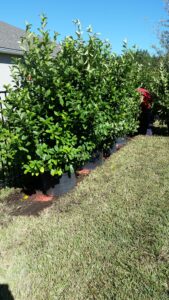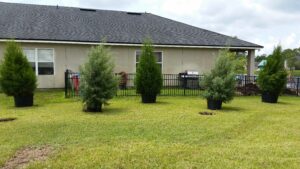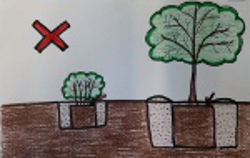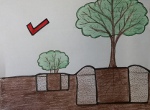Installing Larger Plants and Trees
into the Northeast Florida Landscape

Larger plants and trees should be treated differently when being installed into the Northeast Florida landscapes than small flowers and shrubs. The biggest variation is the amount of soil amendment used at the time of planting.
We recommend amending poorly draining clay soils or really sandy soils when installing larger shrubs, but not when installing larger trees. Mainly because the trees root system, once it has reached it’s full potential, will far exceed the confines of the planting area. This can reduce the effectiveness of soil amendment at the time of planting to the point that it may do more harm than good in some situations.
For example: When planting into hard pan or areas of heavy clay soils, too much soil amendment in the planting hole on a larger tree ( 15 gallon size nursery pot or larger ) can cause the newly growing roots to hit the edge of the amended soil and turn back around to continue to grow in the loose newly added soil rather than branch out into the hard clay around it. It is thought that this can create a root bound tree after being planted into the landscape.

In addition to areas of hardpan or heavy clay soils being an issue in some areas of our Northeast Florida landscape, tree roots will grow out of the amended planting area too quickly to benefit from the added amendments. When installed and watered properly, this
may happen within just a few weeks of installing your new larger trees.
When you do decide to amend the soil on larger plants or trees a more gradual change in soil composition is needed than we use when installing smaller plants into the landscape. It is recommended that when installing larger plants into the landscape, only one third amendment to two thirds native soil is used to back fill planting holes. This will give the new roots a gradual transition from the nursery potting mix the container plants were grown in, to amended native soil, and finally to the native soil that the vast majority of the roots of the larger plants and trees will grow in as their root system
matures.
Installing smaller flowers and shrubs into the landscape? Click on this link for help with
Simple Steps to Install your Larger Plants and
Trees
in the Northeast Florida Landscape
1 – Dig the hole much wider and just a few inches shallower than the size of the pot you purchased. If you dig the hole too deep and end up having to back fill the hole with soil to get to the depth you need, stomp the soil on the bottom of the hole down good with your shoe to help ensure the plant does not settle down into the loosened soil after
planting and end up after all your efforts still being planted too deep.
For 3 Gallon and 7 gallon sized plants we recommend digging the hole at least
twice as wide as the size of the nursery pot you purchased, remembering to dig 1-2 inches shallower than the depth of the soil in the container.
When planting larger trees in 15, 30, and 45 gallon or larger nursery containers it is not advisable to dig the hole much larger than the width of the root ball as the loosened soil will allow the tree to fall over easily during Northeast Florida’s frequent storms. For this reason when installing larger trees, dig the hole just 6 to 12 inches wider than the size of the nursery container that you purchased, remembering to dig 2-3 inches shallower than the depth of the soil in the container.
2– If for some reason you have determined that your soil is in need of amending at the time of planting, add your chosen soil amendments to the native soil you removed from the planting hole in step one and mix no more than one third soil amendment to two thirds native soil. (Native soil is the soil already existing in the landscape where you have chosen to plant your new larger plants and trees.) When planting larger trees (30, 45,
65+ gallon nursery containers) it is not recommended to amend the native
soil when planting in most situations. The new feeder roots that will immediately begin to form when your larger tree is installed and watered properly, will outgrow the amended area in just a few weeks time. For 3, 7 and even sometimes 15 gallon sized shrubs, amendment is more often recommended at the
time of installation as the root system will not grow out of the
amended area nearly as quickly if at all.
3- Remove the plant from the container by tipping it over on it’s side and pulling or cutting off the plastic container.
4 – Take the time to loosen the roots on the outside edges of your larger shrub or tree’s root system. This can be done by using a shovel or hand tool to pry the roots
apart or you may opt to make three or more vertical slits along the side of the root ball that extend from the top of the root all the way down the sides of the root ball to the bottom.
5 – Place your
larger plant or tree into the pre dug hole,
make sure at this time that the root system of the plant you are installing stands a few inches higher than
the existing grade of the landscape soil. If at this time your plant or tree is lower or level with the soil, remove your plant from the hole, back fill with 2 – 3 inches of soil and stomp the back filled soil down with your shoes to compact the soil in the bottom of the hole. Place the tree being installed back in the hole and check again to make sure the root system is a few inches above the grade of the
existing soil in the landscape.
6 – Once you have determined that the plant is placed at the proper planting depth, back fill the rest of the hole with the amended native soil mix. Fill the edges of the hole in one third at a time, tamping the soil down with the other end of your shovel to get rid of the air pockets in the soil. This can also be done by watering with a hose around the root ball to settle the soil and get rid of any air pockets that may have formed while back filling the hole. Doing the back filling then settling in the soil in thirds rather than all at once at the top of the soil will help ensure that the soil has settled down nicely and that the root ball is in complete contact with soil on all sides. Air pockets left when back filling the soil can make your root system dry out quickly and not allow your newly installed larger plants and trees to get the water they need.
7- When installing larger plants and trees in 15 gallon or larger nursery containers, build a small burm around the outside of the root system that will allow the supplemental irrigation water you will be supplying with a hose to remain on top of the root ball rather than running off into the surrounding soil. Be sure to build your burm or ‘water wall’ after the edge of the root ball and not on top of it. This burm will need to be removed or raked into the landscape AWAY FROM THE TREE where it can not be washed back over the top of the root ball you planted during heavy rains.
8- Mulch as needed and water daily for the first two to three weeks ( 30,45,65+ gallon and larger trees will need water daily for two to three months or more to ensure that they have enough water to get those roots growing out into the landscape where your newly installed trees can begin to survive on their own) Lack of water is the number one cause of death on newly planted trees and shrubs. The larger the plant you purchased is, the more water it needs daily and the longer it will require daily watering to establish.
Follow the recommended watering practices of weekly to biweekly for your new larger plants and trees once they have established themselves into the landscape and visible new growth has been observed. See your ‘watering your newly planted plants and trees’ brochure available at the time of purchase. Or call our office and ask for help with your specific plants water needs.
Lack of water is the number one cause of death on newly planted trees and shrubs. Larger container grown plants and trees dry out very quickly after being installed into the Northeast Florida landscape. One day without water during the heat of summer can cause partial root death, and several days in a row without water during the establishment period can mean the death of your new plant or tree. *
It is crucial to the survival of your newly installed larger shrubs and trees that no soil is placed on top of the existing root system of the plant you purchased. The soil that was exposed to the air in the container, should be exposed to the air when your planting is finished.

Drawing depicting plants being installed too deep. Both below grade and with soil placed on top of the rootball that came from the container grown plant that was purchased.

Drawing depicting container grown plants being planted too deep. While the plant was installed correctly ( slightly above the existing grade, perfect for Florida’s sandy soils) Additional soil was still placed on top of the rootball that came out of the plant container. This can lead to stem rot/ poor air intake etc. Mulch can safely be applied to the surface of the root ball because it has large holes for airflow that soil does not.

Drawing depicting ideal placement of smaller shrub and larger tree in Northeast Florida’s sandy soil. Remember sand shifts and moves when runoff occurs after heavy rains. Think of your feet on the beach when a wave comes in and goes out. Your feet settle into that sand deeper. The larger shrubs and trees should be planted 1-2 inches above the existing grade and smaller shrubs should be planted at grade or just slightly higher with NO dirt on top of the existing rootball that came from the container plant. * only mulch gets placed on top of the rootball- NOT DIRT *
watering your newly planted flowers, shrubs and trees.
Click this link for more information on

